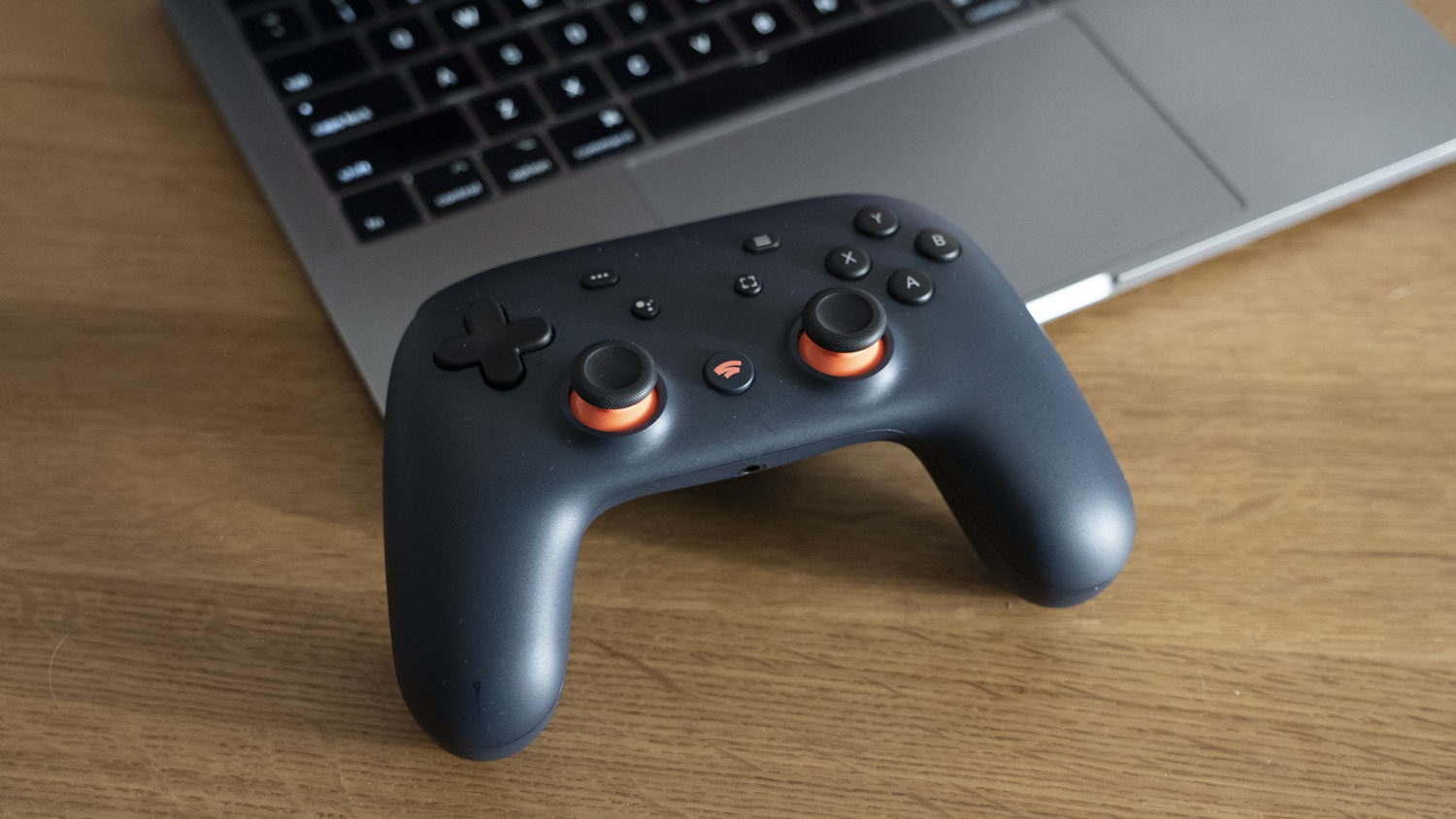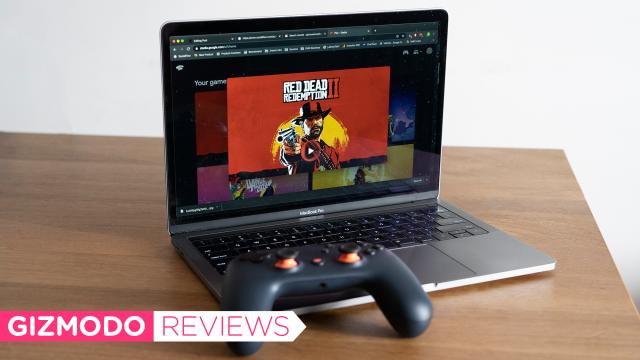When Stadia works perfectly, it feels like the future of gaming. Laptop, phone, and TV: Google’s new game streaming service works across all three with the press of a button or two. The simple controller knows what to connect to and does so with ease. With Stadia, you can slip into a game typically found on a PC or console using almost any device. It makes you wonder why we’ve tethered ourselves to hardware for so long when the internet can give us all of that power at a considerably lower cost (and smaller energy bill). The problem is that Stadia rarely works perfectly. Instead, it offers us a glimmer of the future before crashing back down into the muddy present.
Editor’s Note: Google Stadia isn’t currently available in Australia, and has no scheduled launch date here.
I desperately want to love Stadia because the concept is pretty damn perfect. It’s an idea that Nvidia, Microsoft, and the small French tech company Shadow have all explored. Traditionally, playing a game has required a console or computer that sucks up energy, makes lots of noise, and takes up space in your home. These new streaming gaming services instead rely on fields of servers in some air-conditioned warehouse to handle the actual gameplay, and then stream that gameplay to you over the internet like a super-responsive Netflix. The pitch is that you can play your games anywhere, at any time, provided you have a solid internet connection.

Google Stadia
What is it?
Google's game streaming service.
Price
$US130 ($192)
Like
When it works perfectly it's pretty neat!
No Like
It very rarely works perfectly, and is so unreliable its cost seems outrageous.
The problem, as I’ve noted ad nauseum at this point, is that the internet is rarely as robust as it needs to be to handle game streaming. Unless you live in a big city with access to big internet pipes, game streaming”and even 4K movie streaming”is a pipe dream. The internet in the U.S. is abysmal, particularly in rural areas. I have friends living 60 miles outside of Colorado Springs that struggle with getting HD Netflix streams on their Roku. Stadia would be impossible for them.
That’s because game streaming isn’t really just like streaming Netflix. When you press a button on your controller, that signal has to travel allllll the way to the server, be registered in the game on the server, and then that response has to travel all the way back to your screen, and it has to happen so fast you don’t notice the lag. Plus it has to give you a really sharp high-resolution image, otherwise, it will look like you’re playing your game on a potato.
That all requires a lot of very fast and responsive internet. Microsoft’s Project xCloud and Nvidia’s GeForce Now have both done a decent job of it. If the internet is fast enough, these services can give a good approximation of playing on a console without an actual console. But if the internet isn’t fast enough, the programs will tell you as much”and you’ll have zero games to play.
Unlike those services, Google’s Stadia doesn’t want to tell you no, which means it will operate (very poorly!) on less than ideal internet pipes. The internet at the Gizmodo office can sometimes get bogged down, dropping to a *gasp* mere 20Mbps. That should be more than robust enough for a 720p Stadia stream, but the stream I was served was a stuttering, blurry, and pixellated mess. Playing Destiny 2 on the Chrome browser of my MacBook Pro left me moaning “oh no” over and over again as my character jerked and jostled across the map. It reminded me of when I tried to play World of Warcraft on dial-up.
Erratic performance was fine back when I was playing something like WoW, but Stadia’s stutters made a shooter like Destiny 2 a miserable experience. Red Dead Redemption 2 fared a little better on the service, the game being less reliant on twitchy shots and jumps. But it was still a sub-HD performance that left all the characters looking like blurry blobs.
Stadia worked better on the Chromecast Ultra. Playing on a Pixel 3a provided by Google also gave me better results. (The Stadia app is also technically available on iOS, but downloading it will just remind you that service doesn’t work on iOS devices yet.) The Android app, however, has a major flaw”you can’t easily hop back to the main menu of the app if you’re in a game.
After getting wrecked at a few rounds of Samurai Shodown, I was eager to go try something I’d be less terrible at. On a PS4 or Xbox One, I would’ve been able to tap the branded button at the centre of the controller, taking me to a menu that lets me leave the game and return to the main console screen. No suck luck with Stadia. There is a branded Stadia button at the centre of the controller, but pressing it just revealed a nice menu with some grayed-out options (for features that are not currently available) and the ability to interact with friends. To exit the game I had to instead exit the round I was losing in, go back to the game’s main menu, and then navigate to the “exit to Stadia” option. That’s a few additional steps I really didn’t need. It served as an annoying reminder that Stadia is not done cooking yet.
The service’s biggest rivals, Nvidia GeForce Now, are both currently in beta Nvidia’s offering has been in beta for four years, while Microsoft’s beta launched last month. Google’s Stadia absolutely should have done the same, rather than ask people to spend $US130 ($192) on a buggy service, and then spend $US20 ($29) to $US60 ($88) a piece on the games available on that service.
As it is now, Stadia is a tough sell”particularly when we’re talking about Google. While I might trust Apple or Microsoft to fully commit themselves to a badly launched product like Stadia, Google has a history of cutting its losses. It likes to launch all kinds of neat tools and apps… and then quietly axe them a few years later. Wave. Reader. Plus. Even the rollout of Google’s ISP, Google Fibre, has slowed down nearly to a stop.
There’s also the fact that the pool of people who can really appreciate Stadia’s promise is very, very small. Do you own a PS4 or Xbox One? Congratulations! You have no need of Stadia. Own a Switch? Feel great because you can actually play it in hotels or on planes”something impossible to do with any game streaming service at the moment.
If you don’t own any of those consoles and really want to play games then Stadia could be a solution. It requires significantly less buy-in than a console and is more portable than even the Switch. But right now I just don’t think it’s worth it. Stadia is a beta you have to buy, and that’s never, ever going to be a good idea.
README
-
Stadia is $US130 ($192). A Nintendo Switch Lite is $US200 ($295). Get the Switch Lite.
-
The quality of streaming can be damn abysmal, making it terrible for shooters.
-
The Android app lacks some necessary features. The iOS app is available for download but doesn’t work.
-
It’s a beta that Google wants you to pay money for. Don’t do it.
